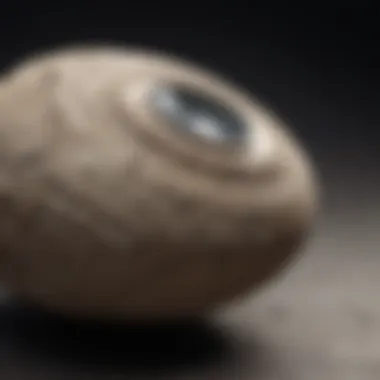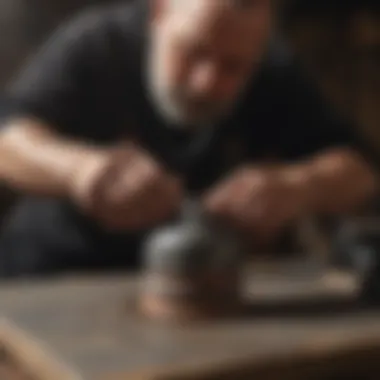Mastering Stone Polisher Tools: A Comprehensive Guide


Rock and Fossil Identification
Understanding and identifying rocks and fossils is an essential foundation for enthusiasts delving into the world of stone polisher tools. By exploring the various types of rocks and fossils, individuals can gain a deeper appreciation for the materials they are working with. Examining the characteristics of different rocks and fossils provides crucial insights for distinguishing between them. Utilizing specialized tools designed for identification purposes can further aid in this detailed exploration.
Collecting Tips and Techniques
Effective collection practices are paramount for gathering high-quality materials for polishing. Implementing best practices ensures that collectors acquire specimens in prime condition. Identifying optimal collecting sites is key to maximizing the potential for finding desirable rocks and fossils. Furthermore, knowledge of safe extraction methods is vital to avoid damage to the specimens during the retrieval process.
Preservation and Display
Preserving rocks and fossils secures their longevity and maintains their aesthetic appeal. Employing proven techniques for preservation helps safeguard the integrity of the specimens. Adhering to proper storage methods, such as controlled humidity levels and temperature regulation, is crucial in preventing deterioration. Additionally, considering creative ideas for displaying rocks and fossils showcases their beauty and fosters admiration for these natural wonders.
Geological Insights
Gaining insights into the geological aspects of rocks and fossils enhances one's understanding of their origins and formation processes. Understanding geological formations and processes provides context for the characteristics of different specimens. Exploring the historical significance of specific rocks and fossils can shed light on their cultural and scientific importance. Studying notable discoveries in the field offers valuable insights into the advancement of knowledge within the realm of rock and fossil collecting.
Introduction
In the realm of stone polishing, the application of stone polisher tools stands as a quintessential aspect, delineating the fine line between mediocrity and excellence in craftsmanship. This article embarks on a journey through the intricate domain of stone polisher tools, shedding light on their pivotal roles in honing the surfaces of various stones with precision and finesse. By delving into the nuances of these tools, enthusiasts and professionals alike can delve into the intricacies of the stone polishing process, gaining a profound understanding of the mechanisms that underpin this art form. As we navigate through the terrains of different types of stone polishers and unlock the essential considerations for selecting the perfect tool for the desired finish, readers will uncover a treasure trove of knowledge that will empower them to elevate their stone polishing endeavors to unprecedented levels of expertise.
Understanding Stone Polisher Tools
Stone polisher tools play a crucial role in the process of enhancing the aesthetic appeal of various types of stones. In this article, we will delve into the intricacies of how these tools work, the benefits they offer, and the essential considerations when using them. Understanding the nuances of stone polisher tools is fundamental for achieving superior results and maintaining the integrity of the stone surfaces. By exploring the different types of tools, their functions, and features, enthusiasts can elevate their stone polishing skills to new heights.
Overview of Stone Polishing Process
Preparation of the Stone Surface


The preparation of the stone surface is a critical initial step in the stone polishing process. This phase involves cleaning the surface, removing any imperfections, and ensuring a smooth foundation for the polishing to take place. By properly preparing the stone surface, the final finish will be enhanced, achieving a glossy appearance. This meticulous preparation ensures that the polishing process is effective and yields professional results.
Application of Abrasives
The application of abrasives is a key element in the stone polishing process, as it involves the use of abrasive materials to grind and polish the stone surface. This step helps in removing scratches, etches, and other imperfections, resulting in a smoother finish. Choosing the right abrasives and understanding their application techniques are essential for achieving the desired level of smoothness and glossiness.
Final Finishing Steps
The final finishing steps involve the last touches to perfect the polished stone surface. This includes buffing, sealing, and applying protective coatings to enhance the durability and appearance of the stone. By paying attention to these final details, the overall quality of the polishing work is significantly improved, resulting in a refined and long-lasting finish.
Types of Stone Polisher Tools
Rotary Tools
Rotary tools are versatile and efficient tools used in stone polishing. They offer high-speed rotation, facilitating quick and precise polishing. The adaptable nature of rotary tools makes them suitable for various types of stones and sizes of surfaces. However, their high speed requires careful handling to avoid damage to the stone surface.
Handheld Polishers
Handheld polishers provide a convenient and portable option for stone polishing. They are effective for smaller or intricate surfaces that require detailed polishing work. The ease of maneuverability and control offered by handheld polishers makes them a popular choice among professionals and DIY enthusiasts. However, limited power and speed settings may influence their efficacy on larger surfaces.
Air Polishers
Air polishers utilize compressed air to power the polishing process, offering a clean and efficient method for stone polishing. The adjustable air pressure allows for precise control over the polishing speed and intensity. Air polishers are ideal for sensitive stone surfaces and intricate designs, providing a delicate yet effective polishing solution.
Key Features to Consider
Power and Speed Settings
The power and speed settings of a stone polisher tool significantly influence its performance and efficiency. Higher power settings enable quicker polishing, while variable speed options offer flexibility in handling different types of stones. Choosing a polisher with adjustable power and speed settings allows for customized polishing results based on the specific requirements of the stone surface.


Pad Size and Material
The size and material of the polishing pad play a crucial role in determining the level of detailing and coverage during the polishing process. Larger pads cover more surface area, reducing the polishing time for larger projects. Additionally, the choice of pad material, such as foam or felt, can impact the smoothness and glossiness of the final finish, requiring careful consideration based on the desired outcome.
Water Feed Mechanism
The water feed mechanism in a stone polisher tool helps in reducing heat generated during the polishing process and removes abrasive debris for a cleaner finish. Proper water flow regulation ensures consistent cooling of the stone surface, preventing overheating and potential damage. Incorporating a water feed mechanism in the polishing workflow contributes to achieving optimal results while maintaining the longevity of the tool.
Professional-Level Results
The utilization of stone polisher tools guarantees professional-level results, characterized by consistency and precision. These tools enable craftsmen to achieve flawless finishes that rival those of seasoned professionals. The consistency in results is a testament to the high-quality output that these tools deliver. Moreover, the minimized risk of damage associated with stone polisher tools ensures that the integrity of the stone is maintained throughout the polishing process.
Consistent and Professional Finish
Consistency and professionalism are at the core of the results produced by stone polisher tools. The key characteristic of this outcome is the ability of the tools to replicate precise finishes repeatedly, setting a professional standard in stone polishing. This feature is a valuable choice for individuals seeking a consistent and polished look across their projects. Additionally, the unique feature of a professional finish lies in its attention to detail, ensuring that every aspect of the stone is refined to perfection.
Minimized Risk of Damage
One of the key advantages of using stone polisher tools is the minimized risk of damage to the stone surface. This aspect is crucial in maintaining the integrity of the material, preventing any potential harm during the polishing process. The key characteristic is the tools' ability to operate gently yet effectively, minimizing the likelihood of scratches or dents on the surface. This feature ensures the longevity of the stone while guaranteeing a flawless finish, making it a preferred choice for professionals prioritizing the preservation of the stone's quality.
Maintenance Tips for Stone Polisher Tools
Stone polisher tools are essential for achieving top-notch results in stone polishing applications. Proper maintenance is crucial to ensure the longevity and efficiency of these tools. By following essential maintenance tips, enthusiasts can preserve the quality of their equipment, leading to optimal performance and cost-effectiveness. Regular maintenance not only enhances the functionality of the tools but also contributes to the overall quality of the finished product. Understanding the significance of maintenance can lead to a hassle-free and productive stone polishing experience.
Cleaning and Storage Practices
Proper Cleaning After Use


Proper cleaning after using stone polisher tools is vital to prevent residue buildup that could affect future polishing tasks. Thoroughly cleaning the equipment removes abrasive remnants and maintains the pads' effectiveness. This practice ensures that the tools are ready for subsequent use, preserving their longevity and performance.
Safe Storage to Avoid Damage
Storing stone polisher tools safely is critical to protect them from environmental factors that may cause deterioration. Proper storage prevents damage to the tools, such as corrosion or wear, extending their lifespan. By safeguarding the tools in a suitable environment, enthusiasts can enhance their longevity and maintain their optimal functioning.
Regular Inspection and Lubrication
Checking for Wear and Tear
Inspecting stone polisher tools for signs of wear and tear is essential to identify any potential issues early. By monitoring the condition of the tools regularly, users can address minor damages promptly, avoiding further complications and ensuring consistent performance. Regular inspections help maintain the tools in top condition, enhancing their efficiency and reliability.
Applying Lubricants for Smooth Operation
Lubricants play a crucial role in ensuring the smooth operation of stone polisher tools. Applying lubricants to moving parts reduces friction, which can improve the tools' efficiency and durability. Proper lubrication enhances the tools' performance, prolonging their lifespan and minimizing the risk of malfunctions during operation.
Safety Precautions
Wearing Protective Gear
Prioritizing the use of protective gear when operating stone polisher tools is paramount to safeguarding against potential hazards. Protective gear, including goggles and gloves, protects users from injuries and ensures a secure working environment. By adhering to safety precautions, enthusiasts can minimize risks and focus on achieving precise and professional polishing results.
Avoiding Overloading the Tool
Avoiding overloading the tool is essential for maintaining its performance and preventing potential damages. Operating the tool within its designated capacity prevents strain on the motor and components, prolonging their lifespan. By using the tool appropriately and avoiding overloading, users can ensure efficient operation and extend the tool's longevity.
Conclusion
The Conclusion section serves as the final piece in the intricate puzzle of stone polisher tools, encapsulating the essence of knowledge gained throughout this comprehensive guide. It is the cornerstone that solidifies the understanding of the importance of proper maintenance and handling of these tools.
One key element highlighted in the Conclusion is the emphasis on regular maintenance and safety practices. Understanding the significance of cleaning, storage, inspection, lubrication, and safety precautions is vital to ensuring the longevity and optimal performance of stone polisher tools. By meticulously following these maintenance tips, enthusiasts can prolong the life of their tools and uphold their efficiency and precision in stone polishing tasks.
Moreover, the Conclusion sheds light on the professional-grade results that can be achieved through the proficient use of stone polisher tools. Consistency and precision in finishing, along with the reduction of manual effort, are crucial benefits that professionals and enthusiasts alike can enjoy. The Conclusion underlines how these tools not only enhance the aesthetic appeal of stones but also contribute to the overall efficiency and effectiveness of various polishing projects.
In summarizing the practical aspects discussed in this guide, the Conclusion serves as a reminder of the importance of selecting the right tools, handling them with care, and incorporating best practices for optimal outcomes. By emphasizing the significance of maintenance, precision, and safety, the Conclusion wraps up the guide by reinforcing the foundation for mastering the art of stone polishing with finesse.







